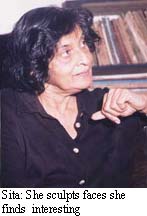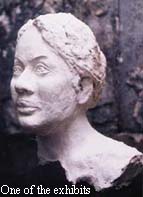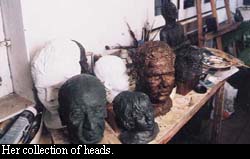 |
 13th June 1999 |
Front Page| |
Making heads"It's hard to explain the satisfaction I get out of sculpting people," says Sita Joseph de Saram whose soul food is this form of artBy Chamila JayaweeraThe sculptress and her seven cats. Sounds intriguing? But this is just the beginning.
Sita is putting the finishing touches to the head of Sunethra Bandaranaike as she speaks. "This is the last piece for my upcoming exhibition," she says, moulding a strand of hair into place. The Retrospective Exhibition of Portrait Sculpture and Portraits will feature 40 "portrait heads" as she refers to them - "I hate the word "bust". This sounds a lot better!"
Despite being a music teacher by profession, sculpting is this lady's soul food. "It's hard to explain the satisfaction I get out of sculpting people," she said passionately. Sita started sculpting at the Ceylon Technical College in Maradana, and held her first exhibition in 1963 at the Lionel Wendt. Her husband, the late cartoonist E.M.W Joseph, who brought to life the character Sooty Banda, was her main source of encouragement and kept her inspired through the years. Most of her sculptures are of well-known personalities, and this has been questioned by her children. "They want to know why I don't just do the people I see on the streets that seem interesting and why I always do public figures," Sita said. She explained this is a concept that is difficult to carry out in Sri Lanka, because people expect to get paid if asked to sit and pose. "This is the wrong attitude to have," she said although she admitted she has seen beggars on the road with some extremely interesting faces. Among the people she has sculpted are President Chandrika Kumaratunga, Arthur C. Clarke, Rabindranath Tagore and George Keyt. "I usually make them sit for about two hours during which period I get down all the details of the face, and after that I work from memory," Sita said, smoothing the clay on her final project. She added that President Kumaratunga's head took longer because she had to find time in her busy schedule to pose, and even then it was only half an hour at a time she could spare.
"It takes me about a couple of weeks to complete the head," Sita said. The clay is kept soft for this duration by carefully wrapping it in wet cloths and plastic. After the work is done, the clay is hollowed out, allowed to dry and then carefully inspected for any appearance of cracks. Sita says she knows her work is successful when people take a glance at a head and recognize the person she has sculpted. "Everyone sees others in a different concept, and they may not see them exactly the way I do. If people fail to comment on the likeness of a person, then I consider my work to have failed." The exhibition will be held on June 19 and 20 at the Lionel Wendt Art Gallery from 10 a.m. to 7 p.m. and will display over 36 years of work.
The glory of mudIt is literally back to earth. In a society now concerned with eco - friendliness, an Indian builder is here to promote mud construction By Ruhanie PereraIn a world taken over by concrete, glass and steel, many feel mud is a thing of the past. Yet it is with the same exuberance of a child making a figure out of clay that Satprem Maini constructs his buildings with mud. What does he find so fascinating about mud? 'Mud', 'unbaked clay' or 'raw earth' is actually a mixture of raw elements. The fascinating thing about this material is that it doesn't require any industrial treatment - in particular no firing - thus saving a great deal of energy and money. There is also natural beauty in clay and it guarantees comfort. Not only is it eco-friendly but it also lasts long. "The best example of this is the vaults in Egypt which have lasted for the past 3300 years," says Maini. Satprem Maini from the Auroville Building Centre in India, is here to conduct a seminar on Earth Architecture (mud construction.) Although he studied architecture in France and became a full-fledged architect, Maini was more interested in mud, which has reappeared in today's world as an economical and ecological alternative. It is this idea that Satprem Maini is trying to introduce in Sri Lanka. And it is with this intention that a seminar was organised at the Alliance Francaise de Colombo on June 5. The seminar was all about the wonders of clay. The programme began with a presentation of various examples of earth architecture in the world. Satprem Maini spoke on the use of compressed earth for sustainable development. There was also a presentation on how building with earth is done in Auroville, India. The final theme for the day was how we can work toward building an eco-friendly habitat. It is Miani's belief that Sri Lanka can benefit from earth architecture because it already exists here.It just needs to be revived he believes. Maini intends this seminar to serve as an awareness builder and then depending on the feedback he hopes to launch a training programme in Sri Lanka. It was Satprem Maini's interest in earth construction that led him to the CRAterre team - a group which began in 1979 in Grenoble. CRAterre is an organisation where researchers, trainers and technicians come together with a definite programme and a global policy with regard to earth construction techniques. As a member of the CRAterre task force Maini has travelled to 14 countries (Somalia, Tunisia, Egypt, Eritrea, Ivory Coast, Zaire, Saudi Arabia, Australia, Brazil, Haiti, Germany, France, Turkey and India) to participate in and conduct training sessions, courses and workshops. But that wasn't enough. To fulfill his dream of developing one place thoroughly, he settled down in India, in Auroville. He has now lived there for ten years and he works in the Auroville building centre under the Indian Housing Urban Development Corporation as a teacher, researcher and builder. |
||
 |
Front Page| News/Comment| Editorial/Opinion| Business| Sports | Mirror Magazine |
|
 |
Please send your comments and suggestions on this web site to |
|
 For
Sita Joseph De Saram, an accomplished sculptress, having seven cats prowling
about in her studio is not easy. Her first job every morning is to check
up on her work and make sure nothing has been knocked down or smashed.
But somehow, her love for her pets is strong enough for her to keep them
around.
For
Sita Joseph De Saram, an accomplished sculptress, having seven cats prowling
about in her studio is not easy. Her first job every morning is to check
up on her work and make sure nothing has been knocked down or smashed.
But somehow, her love for her pets is strong enough for her to keep them
around.  Sita
said that several of the busts and heads that will be on display have been
borrowed from all over the country while others have not been located.
Sita
said that several of the busts and heads that will be on display have been
borrowed from all over the country while others have not been located. Although
she undertakes to do commissions, she said most of her sculptures were
of people she herself had approached because she found their faces interesting.
Although
she undertakes to do commissions, she said most of her sculptures were
of people she herself had approached because she found their faces interesting.